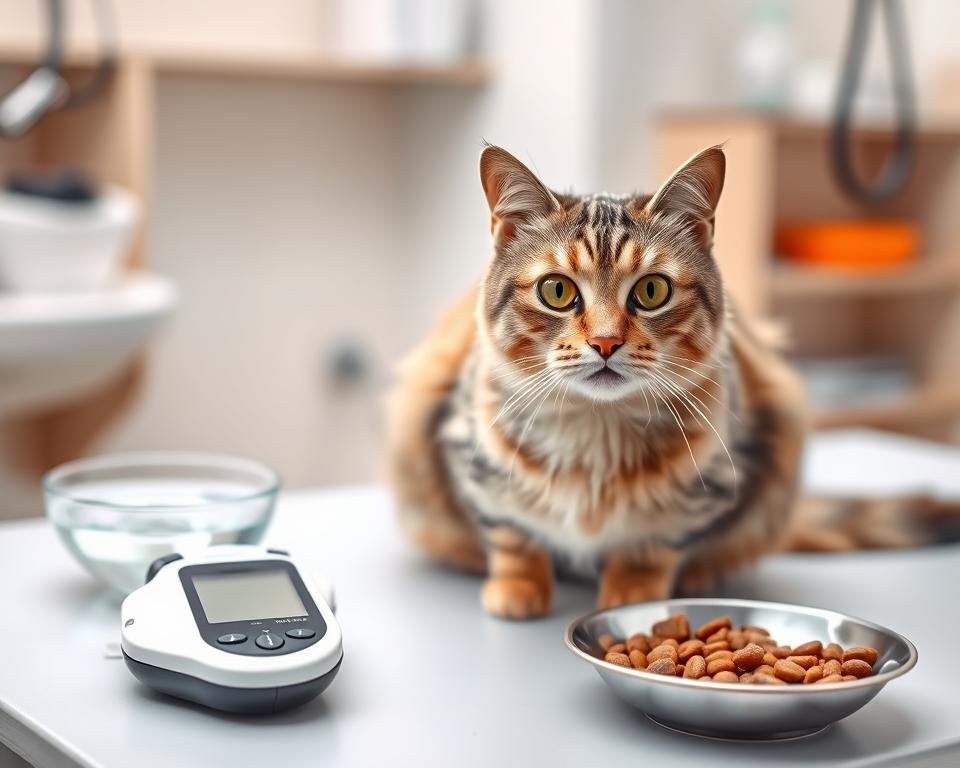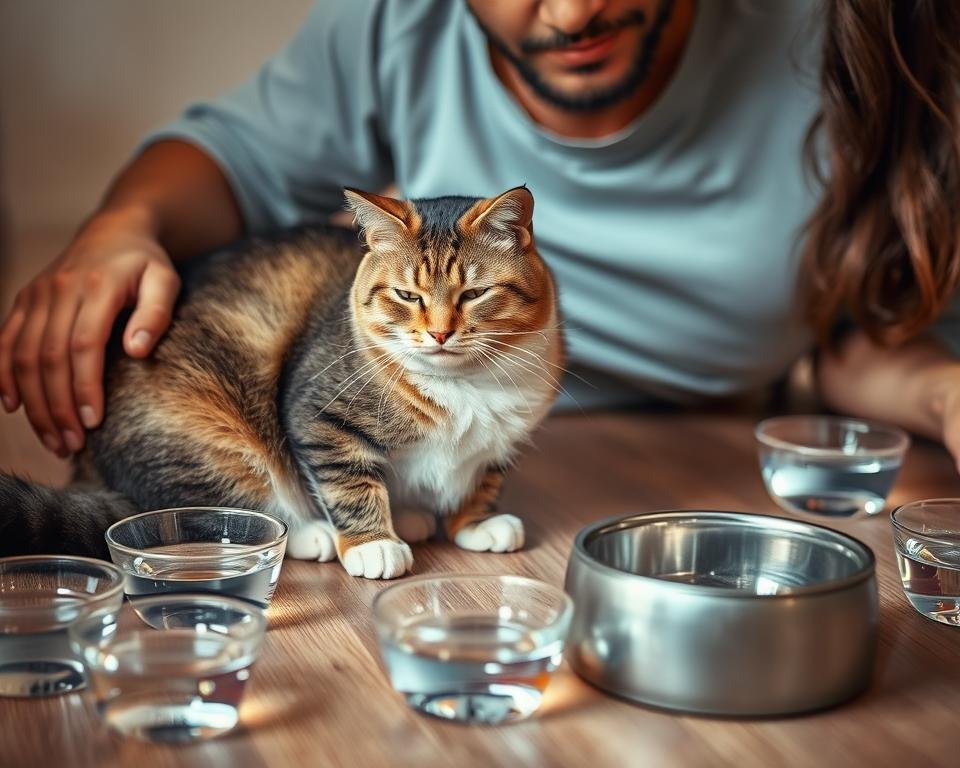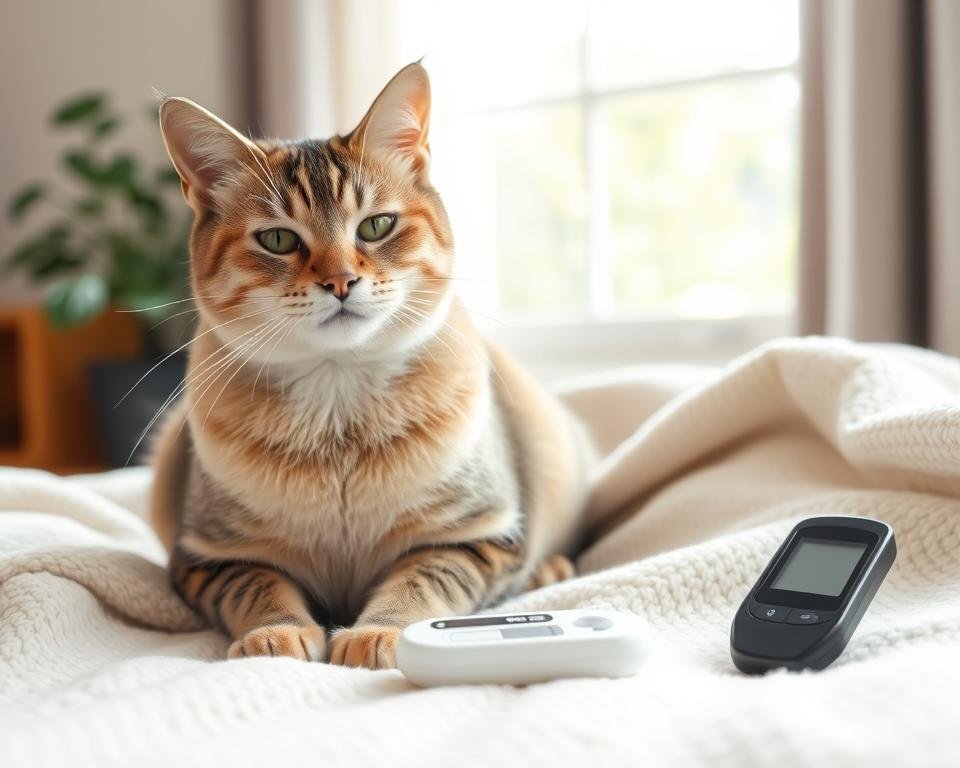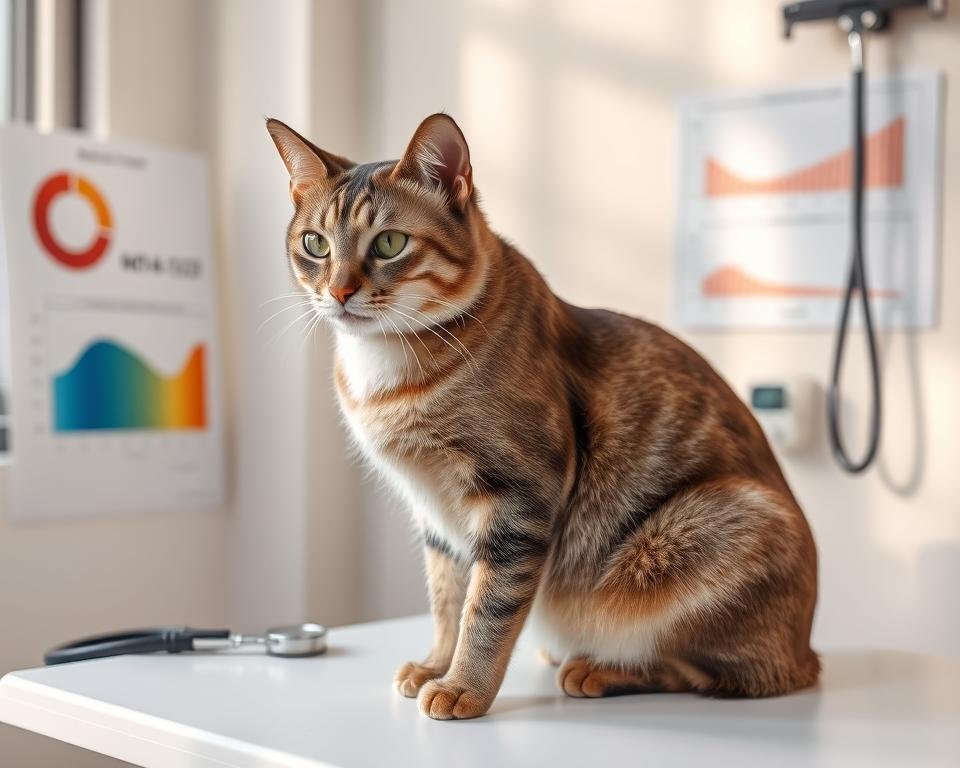Keeping a cat’s blood sugar levels healthy is key to their well-being. This is even more important for cats with diabetes mellitus. Diabetes happens when a cat doesn’t make enough insulin. Insulin helps glucose get into cells from the blood.
Knowing what blood sugar levels are normal for cats is vital. It helps spot and manage diabetes well.
Healthy cats usually have blood sugar between 80-120 mg/dL (4.4-6.6 mmol/L). But, cats with diabetes often have much higher levels. Their blood sugar can go over 400 mg/dL (22 mmol/L) or even 600 mg/dL (33 mmol/L).
High blood sugar can cause symptoms like weight loss, more hunger, and needing to pee a lot. Cats also drink a lot of water.
To find out if a cat has diabetes, vets use blood tests and urine tests. They also do a serum fructosamine test. This test helps tell if the high blood sugar is from diabetes or stress.
By knowing what normal blood sugar levels are for cats, owners can help catch diabetes early. This is important for managing the disease.
Understanding Feline Blood Sugar: The Basics
Cats are amazing creatures, and knowing how they work is key to their health. Their blood sugar, or blood glucose levels, is a vital part of this. It’s the main energy source for cats and is essential for their body to function well.
What is Blood Glucose and Its Role in Cats
Blood glucose is the sugar in a cat’s blood. It comes from their food and is used by their cells for energy. The hormone insulin helps control this by letting glucose into cells for use or storage.
Normal Blood Glucose Range for Healthy Cats
Healthy cats usually have blood glucose between 80-120 mg/dL (4.4-6.6 mmol/L). Keeping their blood sugar in this range is important for their health.
Factors Affecting Blood Sugar Levels
Many things can change a cat’s blood sugar levels, including:
- Diet: What and when a cat eats can affect their blood sugar.
- Stress: Stress can cause a quick rise in blood sugar.
- Underlying health conditions: Some health issues, like diabetes, can mess with blood sugar control.
Knowing about feline blood sugar and what affects it helps cat owners support their pets’ health.

Common Signs of Blood Sugar Abnormalities in Cats
If your cat shows signs of blood sugar abnormalities, it’s important to notice. Diabetes in cats is a serious issue, affecting about 1 in 200 cats. Older cats and certain breeds are more likely to get it.
Some common signs of diabetes in cats include:
- Increased thirst and urination
- Weight loss despite eating more
- Feeling weak or tired
- Dehydration
- Rough, unkempt coat
- Increased belly size
- Unusual posture, such as a plantigrade stance
Not all diabetic cats show all these signs. But if you see at least two, it’s time to see a vet.
Other health issues can also cause these symptoms. So, it’s key to have your vet do tests to confirm diabetes or another problem.

Early detection and treatment of feline diabetes are vital. It can lead to serious health problems if not treated. Knowing the common signs of diabetes in cats helps you get your cat the care they need.
Feline Blood Sugar Levels Normal: Understanding the Target Range
Keeping feline blood sugar levels healthy is key for a cat’s health. The normal blood glucose for cats is between 55-160 mg/dL. Knowing the best levels and how they change daily helps cat owners a lot.
Optimal Blood Glucose Measurements
The best blood sugar range for diabetic cats is 120-300 mg/dL (6.7-16.7 mmol/L) most of the day. This range helps avoid diabetes symptoms and problems. Getting to this range needs careful watching and tailored care.
Daily Fluctuations and Patterns
Daily blood sugar levels in cats can change a lot. Glucose levels are lowest right before insulin and highest a few hours after eating. Knowing these changes is key for managing diabetes and keeping normal blood glucose for cats.
“The duration of insulin action is measured from injection to the time blood glucose exceeds the renal threshold concentration of 14-16 mmol/l in cats.”
Regular checks and working with a vet help cat owners understand their cat’s blood sugar patterns. This ensures the best glucose control.

Monitoring Blood Glucose in Cats
Keeping feline blood sugar levels in check is key for managing cat diabetes symptoms. Veterinarians and cat owners use different ways to check a cat’s blood sugar levels.
One way is to test venous blood samples in a lab or with an in-clinic analyzer. This method gives a clear picture of the cat’s blood sugar levels. For more regular checks, using a glucometer at home on a drop of blood from the cat’s ear is practical.
It’s important to use a glucometer made for cats. This is because cats and humans have different blood sugar ratios. Regular checks help adjust insulin doses and keep blood sugar levels right, avoiding diabetes problems.
Another tool for watching blood sugar is continuous glucose monitors (CGM). Devices like the FreeStyle Libre system give 14 days of glucose data. This helps understand a cat’s blood sugar patterns better. Studies show these CGM systems match blood glucose readings well.
No matter the method, cat owners must work with their vet to understand the data. This helps adjust insulin and diet plans. By being proactive, cat owners can keep their pets’ blood sugar levels healthy and manage cat diabetes symptoms well.

“Monitoring response to insulin and avoiding hyper- and hypoglycemia are vital in managing feline diabetes.” – Veterinary Researcher
The Blood Glucose Curve: A Vital Diagnostic Tool
For cat owners with diabetes, the blood glucose curve is key. It measures blood sugar levels at set times, like every 1-2 hours, over 12-24 hours. This graph shows how well insulin is working and helps figure out the right dose and how often to give it.
How the Curve Works
The curve lets vets watch a cat’s blood sugar all day. They look for levels between 120-300 mg/dL most of the time. This helps them tweak the insulin to keep blood sugar stable and safe.
Interpreting Blood Glucose Curve Results
Vets study the curve to see what insulin a cat needs. They look at the lowest point, how long insulin lasts, and if sugar levels stay steady. They might change the insulin dose or how often it’s given based on this.
When to Perform Testing
They do blood glucose curves at the start of managing diabetes and every 2-4 months after. This keeps the treatment plan working well and lets them make changes as needed.
Understanding the blood glucose curve helps vets and owners manage diabetes in cats better. It ensures cats live their best lives.
Impact of Diet and Feeding on Blood Sugar Levels
Proper diet and feeding are key to keeping feline blood sugar levels normal and managing diabetes in cats. A low-sugar, high-fiber diet is best. It slows down food absorption, preventing sudden blood glucose spikes. Avoid semi-moist foods high in sugar, as they can cause blood sugar to fluctuate.
Prescription high-fiber diets or adding fiber supplements, like psyllium, to regular food can help. They keep blood glucose stable. Also, feeding cats at the same times every day is important. Some studies show that free-choice feeding can keep blood sugar levels steady all day.
| Feeding Approach | Impact on Feline Blood Sugar Levels |
|---|---|
| Low-sugar, high-fiber diet | Slows food absorption, reducing blood sugar spikes |
| Prescription high-fiber diet or added fiber | Helps maintain stable blood glucose levels |
| Consistent feeding schedule | May contribute to more consistent blood sugar levels |
| Free-choice feeding | May help maintain more stable blood glucose levels |
By carefully choosing the right diet and feeding schedule, cat owners can greatly help their pets. This is very important for cats with diabetes.
“Proper dietary management is a critical component in maintaining healthy blood sugar levels in cats, particularlly for those with diabetes.”
Stress Hyperglycemia vs. Diabetes: Important Distinctions
It’s key to know the difference between stress hyperglycemia and diabetes in cats. Cats can see their blood sugar go up during stressful times, like vet visits. This can make it hard to tell if a cat has diabetes.
Understanding Stress-Related Blood Sugar Spikes
Stress can cause cats’ blood sugar to rise. This is because of hormones like cortisol and epinephrine. This rise in blood sugar, called stress hyperglycemia, can look like diabetes.
Differentiating Between Temporary and Chronic Conditions
Vets use the serum fructosamine test to tell stress hyperglycemia from diabetes. This test shows blood sugar levels over the past two weeks. It helps figure out if the high levels are just a temporary thing or a sign of diabetes.
| Condition | Characteristics |
|---|---|
| Stress Hyperglycemia | Temporary increase in blood glucose levels due to stress |
| Diabetes Mellitus | Chronic elevation of blood glucose levels due to insulin deficiency or resistance |
Knowing the difference between stress hyperglycemia and diabetes helps cat owners and vets. They can give the best care to cats, making sure they get the right treatment.
When to Seek Veterinary Care
As a cat owner, knowing the signs of blood sugar issues is key. Cat diabetes symptoms and signs of diabetes in cats are serious and need quick vet care.
Watch for signs like drinking more water, going to the bathroom a lot, losing weight, or feeling tired. These could mean your cat has diabetes. This condition needs careful management to keep your cat healthy.
If your diabetic cat shows signs of ketoacidosis, get them to the vet right away. This is a serious problem that can happen if diabetes isn’t managed well. Look out for vomiting, dehydration, and fast breathing.
Diabetic cats need regular vet visits, every 2-4 months. These check-ups help your vet keep an eye on your cat’s health. They can adjust treatments and make sure blood sugar levels stay in a good range.
| Blood Glucose Recommendations | Optimal Range |
|---|---|
| Healthy Cats | 80-120 mg/dL |
| Diabetic Cats | 120-300 mg/dL |
By watching closely and getting vet care when needed, you can help your diabetic cat stay healthy. This improves their life a lot.
“Successful treatment should improve clinical signs without inducing hypoglycemia.”
Conclusion
Knowing what normal feline blood sugar levels are is key for cat owners. It’s important to watch their blood sugar, feed them right, and give insulin if needed. This helps manage diabetes in cats.
Many diabetic cats can live long, healthy lives with the right care. Early action and treatment make a big difference for cats with blood sugar issues.
Research shows diabetic cats don’t get too high blood sugar after eating typical cat food. This means they don’t need to eat at the same time as taking insulin. This matches how normal and diabetic cats naturally eat.
Getting blood sugar under control quickly can help cats not need insulin anymore. This is a big goal in managing diabetes in cats.
It’s vital for cat owners to know about normal blood sugar levels and manage any problems. Working with vets helps owners care for their cats with diabetes. This way, cats can live long, happy lives.
FAQ
What is the normal blood glucose range for cats?
Healthy cats should have blood glucose levels between 80-120 mg/dL. This is equivalent to 4.4-6.6 mmol/L.
What are the common signs of diabetes in cats?
Cats with diabetes may lose weight even when they eat more. They also drink and urinate more than usual.
What is the target blood glucose range for diabetic cats?
Diabetic cats aim for blood glucose levels between 120-300 mg/dL. This range is for most of the day.
How can I monitor my cat’s blood glucose levels?
You can check your cat’s blood glucose through lab tests or in-clinic analyzers. At-home glucometers also work, using a drop of blood from the ear.
What is a blood glucose curve, and why is it important?
A blood glucose curve measures glucose levels every 1-2 hours for 12-24 hours. It shows how well insulin works and helps adjust treatment. Vets use it to fine-tune insulin therapy.
How does diet impact blood sugar levels in cats?
Cats with diabetes do best on low-sugar, high-fiber diets. These diets slow down digestion and prevent blood sugar spikes. Feeding at the same times every day is also key.
How can stress affect blood sugar levels in cats?
Stress, like vet visits, can raise blood glucose levels. This can make diabetes symptoms seem worse. The serum fructosamine test can tell if it’s stress or true diabetes.
When should I seek veterinary care for my cat’s blood sugar issues?
If your cat shows signs of diabetes often, see a vet. If a diabetic cat seems to have ketoacidosis, get help right away. This is a serious condition.



